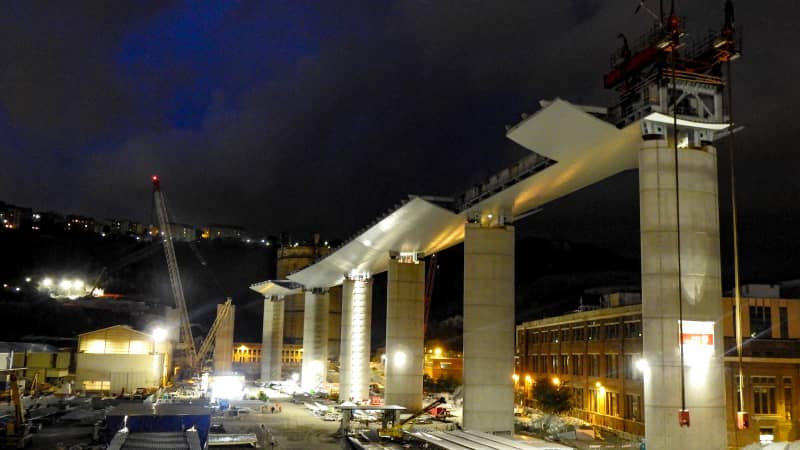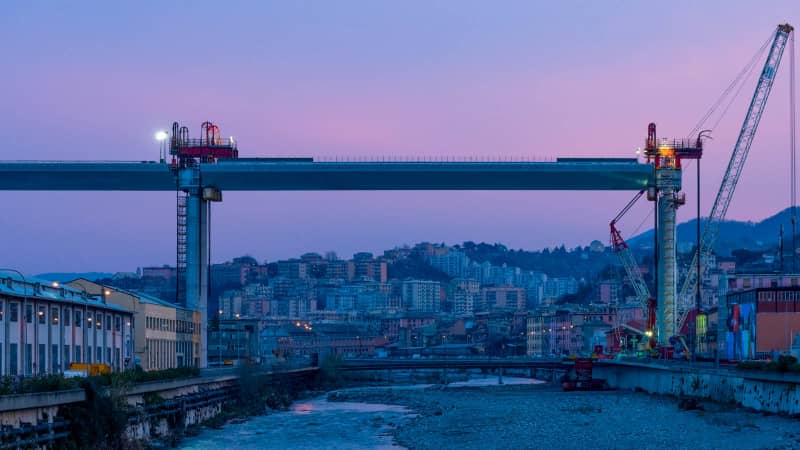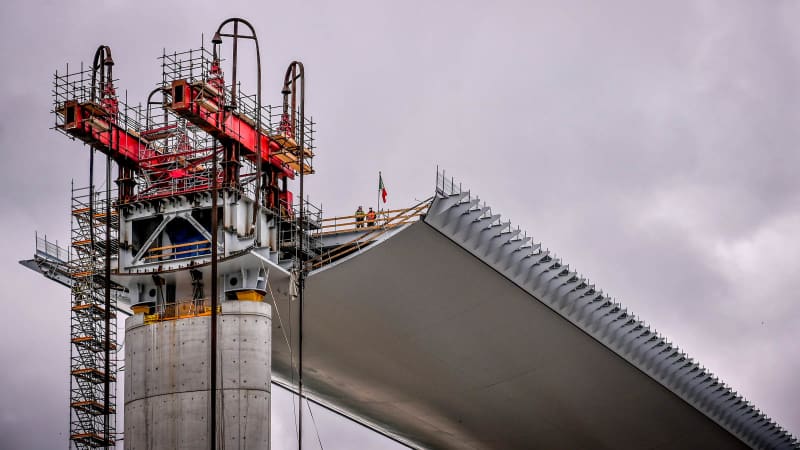(CNN) — High above the Polcevera valley, the final section of a majestic new bridge was hoisted into place this week, signaling the imminent completion of a remarkable engineering project against seemingly impossible odds.
The bridge is a critical traffic artery for northern Italy. It connects two sides of the city of Genoa and serves its busy mercantile port, while being part of the E80 European highway that links Italy to France. It’s also on a main route used by holidaymakers heading to the Ligurian Riviera from cities like Turin and Milan.
More importantly, it was built on the scene of tragedy, replacing an earlier structure, the Morandi bridge, which collapsed on August 14, 2018, killing 43 people.
That the replacement has arrived less than two years after the disaster is something of an achievement.
It was constructed rapidly, in a country rarely considered an exemplar of efficiency. Some of the most challenging work was carried out amid Europe’s worst coronavirus outbreak.
And yet, there it is. Over a kilometer long and standing 45 meters above the valley. Seen from below, it’s designed to look like a ship floating in the sky.
“Genoa is a shipmaking city, so it’s not bizarre to make the bottom of the bridge look like a ship’s hull,” Renzo Piano, who designed the new bridge, tells CNN Travel. It adds to a portfolio that includes the Shard in London, the Whitney Museum in New York and the Centre Pompidou in Paris. A Genoa native, Piano also worked on a bold redesign of the city’s waterfront in the 1990s.
“I wanted this bridge to tell a story about Genoa,” says Piano. “A famous Genoese poet, Giorgio Caproni, wrote beautifully that Genoa is made of steel and breeze. This bridge will be a portrait of the city. It’s made of steel, but it’s also flirting with the breeze. It will be flying over the valley. It will be strong and powerful, but simple, like a beautiful song.”
Closing a wound
In a ceremony limited in scope by the lockdown still enforced across the country, Italian premier Giuseppe Conte said that a wound was being closed, although one that can never fully heal. He added that Genoa was “shining a new light over Italy.”
From his home in Paris, Renzo Piano watched with “a mix of pride, affection, sadness and a bit of melancholy, because the big adventure part of the project is done, the part when you take pieces of steel that weigh 2,000 tons and make them fly from the ground to a height.”
The collapsed Morandi bridge, named after the engineer who designed it, Riccardo Morandi, was completed in 1967.
It had the same structure as the Brooklyn Bridge, which it vaguely resembled, but it was made mostly of concrete rather than steel, because Italy didn’t have the required supply of the metal at the time.
The steel stays, or cables, that supported the deck were also covered in concrete, and the structure of the bridge was lacking any redundancies that could have prevented a collapse in case of failure.
When one of the main pylons fell during mid-morning traffic, it brought with it a section of road spanning 600 feet that crashed down on the railway and buildings below, leading to the evacuation of hundreds.
The exact cause of the collapse is still under investigation, but corrosion, construction defects, improper maintenance and a design that was beyond its load limits have all been identified as contributing factors.
Piano’s new design does away with cables entirely. It’s a streamlined steel beam supported by 18 reinforced concrete piers, spaced 160 feet apart except for the three central ones, where the gap widens to 320 feet because of the river and railway. The design is meant to reflect the character of the city itself.
“Genoa is a city of silence in some way, and this is what the bridge does: It goes through the valley in silence, putting its feet where it can, almost asking for permission. Maybe that’s part of the inspiration, because when you have a tragedy, the first reaction must be silence.”
Non-stop work

Work on the bridge has been going on 24/7 to complete the project in a year.
Courtesy RPBW Architects
The new bridge was built by Salini Impregilo, an Italian construction company, and Fincantieri, a state-owned shipbuilder. The project cost 200 million euros, about $220 million, not considering the cost of demolition of the Morandi bridge, which cost another 90 million euros, or about $98 million.
“Normally it would take three to three and a half years to design and build a bridge of this size. This one took a little over a year,” says construction manager Stefano Mosconi, who added that up to 1,000 people were working on the project at the same time.
To speed things up, construction took place less than 20 meters south of the fallen bridge, so that it could start while the cleanup work was still in progress.
“This bridge is not just a stretch of highway. It also links two parts of the city of Genoa, so it was very important to have it working as soon as possible,” Mosconi adds. “We also wanted to respond to a very negative event, a huge tragedy, with a positive force, by building a safer bridge faster than ever before.”
Piano says that the project attracted a high level of expertise, which makes it less surprising that it could be achieved in such a short time.
“It’s not a miracle. It’s just what happens when competence wins over incompetence. Italy is a special country, with capacity to do things — unfortunately that capacity only comes out when there’s a tragedy. I hope this bridge will teach something to people.”
Work on the site never stopped, continuing at night with tasks deemed compatible with noise regulations.
When Italy went into lockdown in early March, strict safety measures were enforced and the project was allowed to continue due to its national and strategic importance.
Only one worker tested positive on the site, in late March, and he has since returned to work along with colleagues who had been in contact with him and had been quarantined.
Opening in July
To ensure the tragedy never repeats, the bridge is equipped with its own monitoring system, as well as a fleet of robots that run along the hull to spot any sign of trouble.
It is designed to last at least 100 years.
Despite the inauguration, however, it isn’t finished. While the structure is complete, the asphalt road is still to be laid down and won’t open to traffic until July at the earliest.
For that reason, the bridge doesn’t yet have a name, which will be decided later (Piano suggested calling it simply “Genova.”)
Even so, 620 days after the tragedy, the new bridge already represents a beacon of hope and pride for Italy, as the country prepares to ease lockdown measures after coronavirus claimed close to 30,000 lives.
“The story of this bridge shows that the competence is there, the technology is there, even the passion is there,” Piano says. A new building project “is a gesture of optimism. I’m not surprised that somebody takes it as a sign of hope.”


